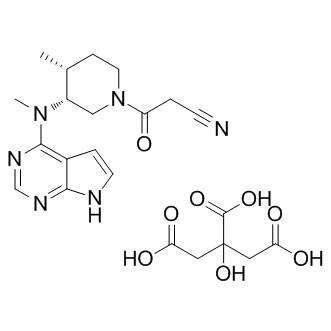| In Vivo: |
Animals that are treated with Tofacitinib show a significantly lower production of anti-drug antibodies (ADAs) compare with PEG-treated control mice (for five weeks after initial immunization, p<0.01, n=8). Moreover ADAs become detectable earliest on day 28. A difference of 1000- to 200-fold in titers to SS1P is apparent from days 21 through 35, respectively. Compare to SS1P, mice injected with keyhole limpet hemocyanin (KLH) generate a more rapid antibody response. Yet, the administration of Tofacitinib reduces anti-KLH titers compare to controls (p<0.05 on day 21, p<0.01 on day 28, respectively, n=5). Reductions in titers ranged from 5000- to 250-fold from days 21 through 28, respectively[2]. Based on previous dose-response studies, a daily dose of Tofacitinib of 6.2 mg/kg is selected to provide 80% inhibition of hind paw volume and plasma exposure capable of suppressing the JAK1 and JAK3 signaling pathways for >4 hours[3]. |
| In Vitro: |
Tofacitinib (CP-690550) citrate binds potentially at JAK3 and JAK2 as 2.2 nM and 5 nM (Kd). The report includes additional binding for Tofacitinib at Camk1 (Kd of 5,000 nM), DCamkL3 (Kd of 4.5 nM), Mst2 (Kd of 4,300 nM), Pkn1 (Kd of 200 nM), Rps6ka2 (Kin.Dom.2-C-terminal) (Kd of 1,400 nM), Rps6ka6 (Kin.Dom.2-C-terminal) (Kd of 1,200 nM), Snark (Kd of 420 nM), Tnk1 (Kd of 640 nM) and Tyk2 (Kd of 620 nM)[1]. K562, KCL22, and THP-1 cells are exposed to different doses of Imatinib (IMA) or JAK inhibitors for 72 h to quantify the effects of tyrosine kinase inhibitor (TKI) activity. Cell growth inhibition is then evaluated using the MTT assay. The proliferation of K562 and KCL22 cells, but not THP-1 cells, is inhibited by IMA in a concentration-dependent manner. The IC50 value of IMA is 0.28 µM for K562 and 0.17 µM for KCL22. Although treatment with Tofacitinib (TOF) or Ruxolitinib (RUX) alone does not suppress cell proliferation, both Tofacitinib and Ruxolitinib make the K562 and KCL22 more sensitive to IMA[4]. |






















